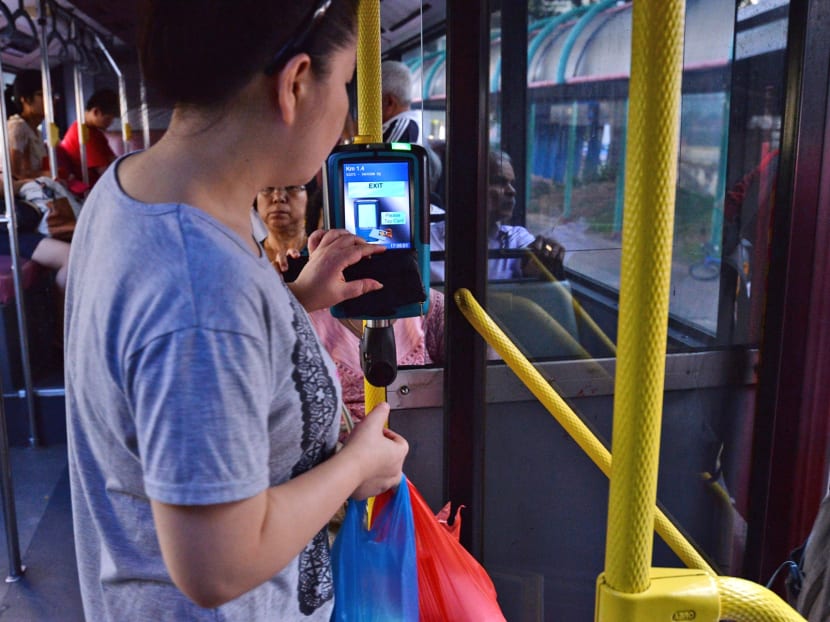Mastercard holders can soon use cards to pay for train, bus fares
SINGAPORE — Commuters who are Mastercard holders are set to be among the first here to tap their credit and debit cards to pay for train and bus fares, which will be billed directly to their accounts, bypassing any top-up arrangements.
SINGAPORE — Commuters who are Mastercard holders are set to be among the first here to tap their credit and debit cards to pay for train and bus fares, which will be billed directly to their accounts, bypassing any top-up arrangements.
The Land Transport Authority (LTA), which first announced the pilot in March, has partnered with Mastercard to offer this option by the end of this year, with the aim of reaching 100,000 users.
And up next could be Visa cardholders — the company, when contacted, said it was in talks with the LTA on using its cards for bus and train journeys. Called the Account-Based Ticketing System, commuters will be able to monitor their journey and fare history through a mobile app or Web portal. It makes use of bank cards that are on the EMV (Europay, MasterCard and Visa) contactless standards.
More details of the pilot will be announced at a later date, said the LTA and Mastercard in a joint press release issued on Monday (July 25).
Currently, apart from using the EZ-Link card, other fare payment options include credit cards that come with the EZ-Reload function, which allows for the card to be automatically topped up, and the amount charged to the credit card.
A convenience fee is usually levied on the EZ-Reload function, which also allows one to link an EZ-Link card to credit and debit cards or bank accounts for top-ups. But this is waived for Visa or MasterCard cards issued by DBS/POSB or Citibank.
Commuters using compatible Near-Field Communications-enabled (NFC) phones can also pay for rides with their phones by buying an EZ-Link NFC SIM card.
With contactless payment technologies evolving quickly to offer consumers more options, experts felt the ubiquitous EZ-Link card, which has limited functions on its own, could decline in use, although it remains necessary for certain user groups such as the elderly or children.
Associate Professor of Marketing Ang Swee Hoon from the National University of Singapore Business School said having a contactless card system for public transport will bring more convenience to commuters, as they are not required to have so many cards at hand.
Mr Michael Yeo, senior market analyst at IDC Financial Insights, noted the higher costs of maintaining the EZ-Link ecosystem, compared to options such as NFC payments.
“It is not a stretch to think that, down the line, LTA will also look to phase out EZ-Link in favour of card-based payments,” he said, adding it would be a “great advantage” for tourists who can use their NFC phones or their bank cards when they travel here.
To compete with other contactless payment options, UniSIM senior lecturer Park Byung Joon felt that EZ-Link needs to expand its uses for commuters. “Its days are going to be numbered, so if it wants to stay in the business, we should be able to pay for something else with the EZ-Link card,” said Dr Park, noting that the card can be used only at certain retail outlets.
As for whether commuters will take to the new options, SIM University senior lecturer Walter Theseira said the transaction costs of signing up for the scheme, such as the number of forms that need filling, would be a key factor.
The “ideal implementation” would be one where there is no sign-up needed by a commuter, said Dr Theseira. “If registration is required, I expect that some incentives will be needed to drive adoption,” he added.
He also pointed out that the EZ-Link card will continue to be important for commuters who do not have access to other contactless payment devices, such as those with very low incomes, foreign workers and students.
Dr Ernie Teo, a research fellow at the Sim Kee Boon Institute for Financial Economics, pointed out that current contactless payment modes have very low switching costs. To take the lead in the market, a payment platform would need to cover even offline payments and offer value-added services, he said.
For example, the Alipay app in China is not limited to point-of-sale terminals. It also allows users to transfer funds to other users, or to pay for a movie. “These services create consumer stickiness and a dominant platform,” Dr Teo added







